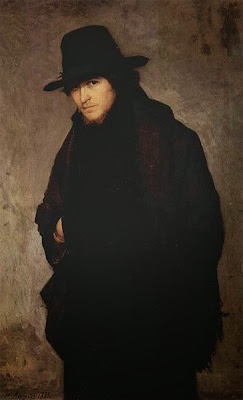 |
| Nikolai Yaroshenko (1846-1898) The Student |
“Is black part of your palette when mixing colors? Many artists state that they never use black but I don't understand if they mean that they don't like using it straight out of the tube on to the canvas or if they banned it even as a mixing component from their palette altogether.”
Hi, Kostas,
Good question and comment. Let me try answering them, and I'll ask a few more questions. I will do this as a three-part series.
Can you use black to darken a color?
Black is a very useful color. However many artists will tell you that if it is used to darken all the colors, it can "muddy" a color scheme. They are right. That's because black pigment will reduce chroma too quickly as it darkens or "tones" a color. Rather than looking like a darker version of the color, a color mixed with black will be both darker and a lot grayer, which can give the picture an unpleasant dullness. Another problem with black in mixtures is that it will often shift a hue toward another hue. For example, yellow turns green when mixed with black.
David Briggs explains these phenomena on his excellent website HueValueChroma. In this diagram from his page on mixing with black, he compares how a mixture of permanent alizarin and white (A) changes as it is darkened by black, compared to a line of uniform saturation (B). The pigment mixtures are plotted using software from the website couleur.org.
How do you darken a color without using black?
To avoid that problem, painters use a variety of colors to darken or tone other colors. Usually these toning colors are pigments that appear dark right out of the tube, often because they are transparent. Ultramarine, the phthalo blues and greens, burnt umber, and permanent alizarin crimson can all be useful for toning other colors. By using these colors to darken your mixtures, you can control the chroma and, if you need to, pull it away from dullness, or just give it more interesting variations of chroma as the colors get darker, so that the dark realms of your colors aren't all monochromatic.
What are the uses for black?
Despite its tendency to be a color-mixing crutch for beginners, black has its uses. I love black pigment. I have a tube of black in all the media I paint with: oil, casein, gouache, and watercolor. I use black pigment most often when I'm painting in grisaille with just black and white, or in a super-limited palette of black, white, and another color. I also use it if I want an accent of the darkest possible value (more about that on Sunday).
Are all black pigments the same?
No. In watercolor, it's fun to experiment with different kinds of black: bone black, lamp black, Mars black. The pigment called "ivory black" used to be made from elephant ivory. Since that is now unavailable, some paint makers create ivory black by burning and grinding up fragments of mammoth ivory from Russia, which is legal to use. Each kind of black has different qualities of texture and chroma. If you get a couple of different blacks, you can play with them and compare them by painting them in a thin glaze, tinting them with white, and mixing them with other colors.
"Questions about Black" Series
Part 2: Mixing your own blackPart 3: Using black in a painting
Part 4: Is Black a color?
Get my book "Color and Light" signed from my website or from Amazon

